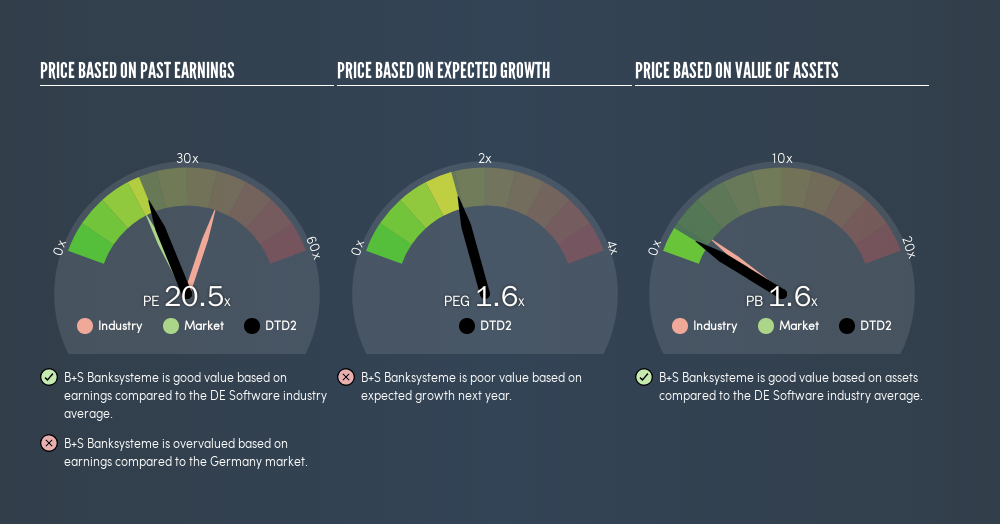Do You Like B+S Banksysteme Aktiengesellschaft (FRA:DTD2) At This P/E Ratio?

This article is for investors who would like to improve their understanding of price to earnings ratios (P/E ratios). We'll look at B+S Banksysteme Aktiengesellschaft's (FRA:DTD2) P/E ratio and reflect on what it tells us about the company's share price. B+S Banksysteme has a price to earnings ratio of 20.47, based on the last twelve months. That corresponds to an earnings yield of approximately 4.9%.
Check out our latest analysis for B+S Banksysteme
How Do I Calculate A Price To Earnings Ratio?
The formula for P/E is:
Price to Earnings Ratio = Share Price ÷ Earnings per Share (EPS)
Or for B+S Banksysteme:
P/E of 20.47 = €3.52 ÷ €0.17 (Based on the year to June 2018.)
Is A High Price-to-Earnings Ratio Good?
A higher P/E ratio means that buyers have to pay a higher price for each €1 the company has earned over the last year. All else being equal, it's better to pay a low price -- but as Warren Buffett said, 'It's far better to buy a wonderful company at a fair price than a fair company at a wonderful price.'
How Growth Rates Impact P/E Ratios
Probably the most important factor in determining what P/E a company trades on is the earnings growth. When earnings grow, the 'E' increases, over time. That means unless the share price increases, the P/E will reduce in a few years. So while a stock may look expensive based on past earnings, it could be cheap based on future earnings.
B+S Banksysteme saw earnings per share decrease by 36% last year. But over the longer term (5 years) earnings per share have increased by 26%.
How Does B+S Banksysteme's P/E Ratio Compare To Its Peers?
The P/E ratio indicates whether the market has higher or lower expectations of a company. The image below shows that B+S Banksysteme has a lower P/E than the average (38.3) P/E for companies in the software industry.

B+S Banksysteme's P/E tells us that market participants think it will not fare as well as its peers in the same industry. Since the market seems unimpressed with B+S Banksysteme, it's quite possible it could surprise on the upside. If you consider the stock interesting, further research is recommended. For example, I often monitor director buying and selling.
Don't Forget: The P/E Does Not Account For Debt or Bank Deposits
Don't forget that the P/E ratio considers market capitalization. Thus, the metric does not reflect cash or debt held by the company. Theoretically, a business can improve its earnings (and produce a lower P/E in the future), by taking on debt (or spending its remaining cash).
Such expenditure might be good or bad, in the long term, but the point here is that the balance sheet is not reflected by this ratio.
Is Debt Impacting B+S Banksysteme's P/E?
B+S Banksysteme has net debt worth just 7.1% of its market capitalization. It would probably trade on a higher P/E ratio if it had a lot of cash, but I doubt it is having a big impact.
The Bottom Line On B+S Banksysteme's P/E Ratio
B+S Banksysteme trades on a P/E ratio of 20.5, which is above the DE market average of 18.3. With modest debt but no EPS growth in the last year, it's fair to say the P/E implies some optimism about future earnings, from the market.
Investors should be looking to buy stocks that the market is wrong about. People often underestimate remarkable growth -- so investors can make money when fast growth is not fully appreciated. So this freevisualization of the analyst consensus on future earnings could help you make the right decision about whether to buy, sell, or hold.
But note: B+S Banksysteme may not be the best stock to buy. So take a peek at this freelist of interesting companies with strong recent earnings growth (and a P/E ratio below 20).
We aim to bring you long-term focused research analysis driven by fundamental data. Note that our analysis may not factor in the latest price-sensitive company announcements or qualitative material.
If you spot an error that warrants correction, please contact the editor at editorial-team@simplywallst.com. This article by Simply Wall St is general in nature. It does not constitute a recommendation to buy or sell any stock, and does not take account of your objectives, or your financial situation. Simply Wall St has no position in the stocks mentioned. Thank you for reading.
About DB:DTD2
B+S Banksysteme
Provides software solutions for banks and financial service providers.
Undervalued with solid track record.
Market Insights
Community Narratives



